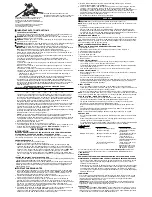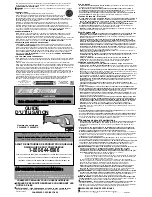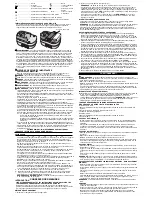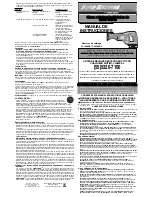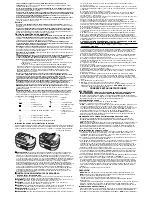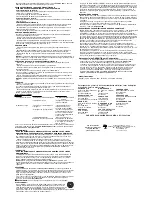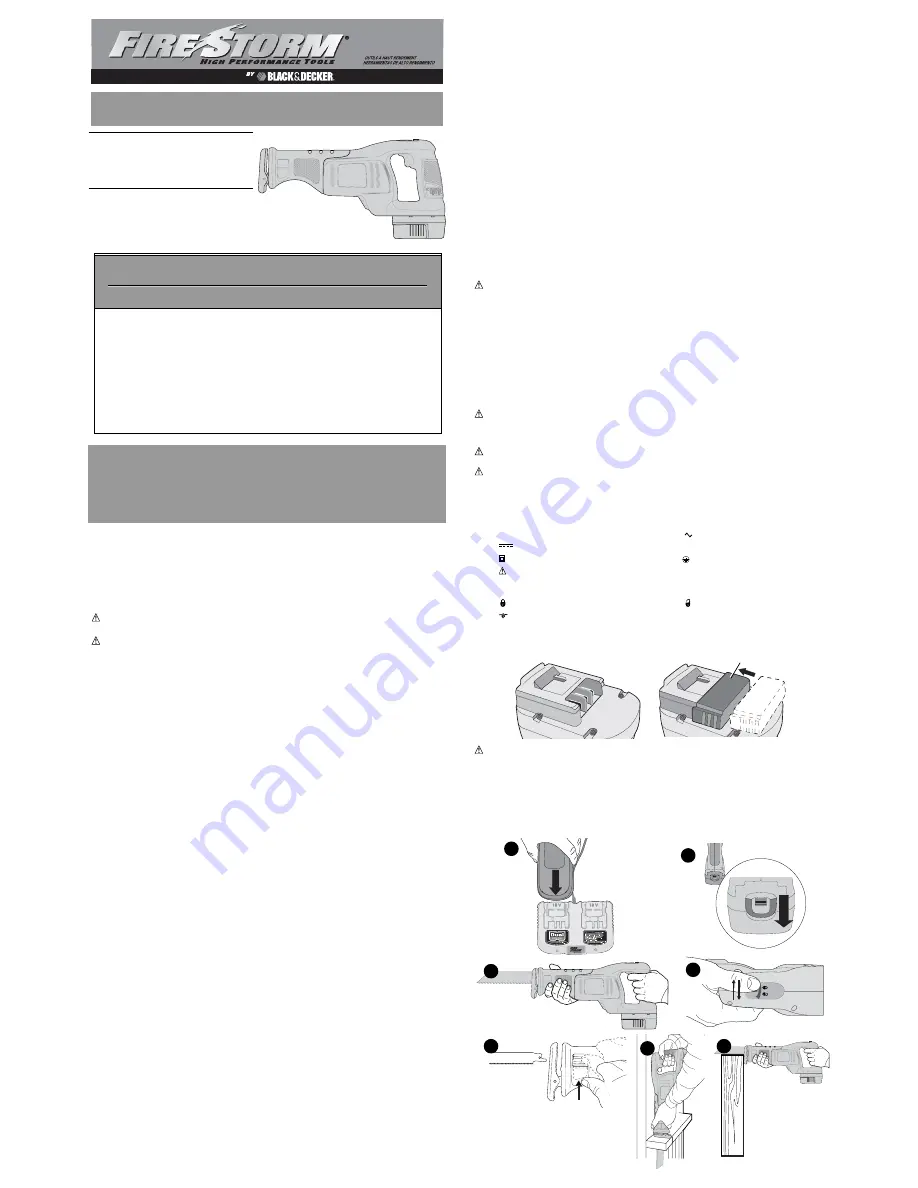
• Maintain tools with care. Keep cutting tools sharp and clean.
Properly maintained tools,
with sharp cutting edge are less likely to bind and are easier to control.
• Check for misalignment or binding of moving parts, breakage of parts, and any other
condition that may affect the tool’s operation. If damaged, have the tool serviced
before using.
Many accidents are caused by poorly maintained tools.
• Use only accessories that are recommended by the manufacturer for your model.
Accessories that may be suitable for one tool may create a risk of injury when used on
another tool.
Service
• Tool service must be performed only by qualified repair personnel.
Service or
maintenance performed by unqualified personnel may result in a risk of injury.
• When servicing a tool, use only identical replacement parts. Follow instructions in
the Maintenance section of this manual.
Use of unauthorized parts or failure to follow
Maintenance Instructions may create a risk of shock or injury.
SPECIFIC SAFETY RULES
•
Hold tool by insulated gripping surfaces when performing an operation where the
cutting tool may contact hidden wiring or its own cord.
Contact with a "live" wire will
make exposed metal parts of the tool "live" and shock the operator.
•
Use extra caution when cutting overhead and pay particular attention to overhead
wires which may be hidden from view. Anticipate the path of falling branches and
debris ahead of time.
•
KEEP HANDS AWAY
from cutting area. Never reach underneath the material for any
reason. Hold front of saw by grasping the contoured gripping area. Do not insert fingers or
thumb into the vicinity of the reciprocating blade and blade clamp. Do not stabilize the saw
by gripping the shoe.
• KEEP BLADES SHARP.
Dull blades may cause the saw to swerve or stall under
pressure.
WARNING: Some dust created by power sanding, sawing, grinding, drilling, and
other construction activities contains chemicals known to cause cancer, birth
defects or other reproductive harm
. Some examples of these chemicals are:
• lead from lead-based paints,
• crystalline silica from bricks and cement and other masonry products, and
• arsenic and chromium from chemically-treated lumber (CCA).
Your risk from these exposures varies, depending on how often you do this type of work. To
reduce your exposure to these chemicals: work in a well ventilated area, and work with
approved safety equipment, such as those dust masks that are specially designed to filter
out microscopic particles.
•
Avoid prolonged contact with dust from power sanding, sawing, grinding, drilling,
and other construction activities. Wear protective clothing and wash exposed areas
with soap and water.
Allowing dust to get into your mouth, eyes, or lay on the skin may
promote absorption of harmful chemicals.
WARNING: Use of this tool can generate and/or disperse dust, which may cause
serious and permanent respiratory or other injury.
Always use NIOSH/OSHA approved
respiratory protection appropriate for the dust exposure. Direct particles away from face and
body.
CAUTION: Wear appropriate hearing protection during use.
Under some conditions
and duration of use, noise from this product may contribute to hearing loss.
WARNING:
Do not operate this tool for long periods of time.
Vibration caused by
the operating action of this tool may cause permanent injury to fingers, hands, and arms.
Use gloves to provide extra cushion, take frequent rest periods, and limit daily time of use.
The label on your tool may include the following symbols.
V ..........................volts
A..........................amperes
Hz ........................hertz
W ........................watts
min ........................minutes
......................alternating current
......................direct current
no ........................no load speed
..........................Class II Construction
........................
earthing terminal
........................safety alert symbol
.../min ..................revolutions or
reciprocations
per minute
........................lock-on symbol
........................lock-off symbol
........................Quick Release lock-on symbol
BATTERY CAP INFORMATION
Battery storage and carrying caps are provided for use whenever the battery is out of the
tool or charger. Remove cap before placing battery in charger or tool.
WARNING:
Do not store or carry battery so that metal objects can contact exposed
battery terminals. For example, do not place battery in aprons, pockets, tool boxes,
product kit boxes, drawers, etc. with loose nails, screws, keys, etc. without battery cap.
Transporting batteries can possibly cause fires if the battery terminals inadvertently come
in contact with conductive materials such as keys, coins, hand tools and the like. The US
Department of Transportation Hazardous Material Regulations (HMR) actually prohibit
transporting batteries in commerce or on airplanes (i.e. packed in suitcases and carryon
luggage) UNLESS they are properly protected from short circuits. So when transporting
individual batteries, make sure that the battery terminals are protected and well insulated
from materials that could contact them and cause a short circuit.
CAT. NO. FS1800RS/FS2400RS FORM NO. 609746-08 REV. 1
Printed in China
Copyright©2006 Black & Decker
(MAR. ‘06)
VEA EL ESPAÑOL EN LA CONTRAPORTADA.
SAVE THIS MANUAL FOR FUTURE REFERENCE.
INSTRUCTIVO DE OPERACIÓN, CENTROS DE SERVICIO Y
PÓLIZA DE GARANTÍA. ADVERTENCIA: LÉASE ESTE
INSTRUCTIVO ANTES DE USAR EL PRODUCTO.
CATALOG NUMBERS
FS1800RS / FS2400RS
INSTRUCTION
MANUAL
GENERAL SAFETY RULES - FOR ALL BATTERY OPERATED TOOLS
WARNING! READ AND UNDERSTAND ALL INSTRUCTIONS
.
Failure to follow all instructions listed below, may result in electric shock, fire and/or
serious personal injury.
SAVE THESE INSTRUCTIONS
Work Area
•
Keep your work area clean and well lit.
Cluttered benches and dark areas invite
accidents.
• Do not operate power tools in explosive atmospheres, such as in the presence of
flammable liquids, gases, or dust.
Power tools create sparks which may ignite the dust or
fumes.
• Keep bystanders, children, and visitors away while operating a power tool.
Distractions can cause you to lose control.
Electrical Safety
• Do not abuse the cord. Never use the cord to carry the tool. Keep cord away from
heat, oil, sharp edges or moving parts. Replace damaged cords immediately.
Damaged cords may create a fire.
• A battery operated tool with integral batteries or a separate battery pack must be
recharged only with the specified charger for the battery.
A charger that may be
suitable for one type of battery may create a risk of fire when used with another battery.
• Use battery operated tool only with specifically designated battery pack.
Use of any
other batteries may create a risk of fire.
Personal Safety
• Stay alert, watch what you are doing and use common sense when operating a
power tool. Do not use tool while tired or under the influence of drugs, alcohol, or
medication.
A moment of inattention while operating power tools may result in serious
personal injury,
• Dress properly. Do not wear loose clothing or jewelry. Contain long hair. Keep your
hair, clothing, and gloves away from moving parts.
Loose clothes, jewelry, or long hair
can be caught in moving parts.
• Avoid accidental starting. Be sure switch is in the locked or off position before
inserting battery pack.
Carrying tools with your finger on the switch or inserting the battery
pack into a tool with the switch on invites accidents.
• Remove adjusting keys or wrenches before turning the tool on.
A wrench or a key that
is left attached to a rotating part of the tool may result in personal injury.
• Do not overreach. Keep proper footing and balance at all times.
Proper footing and
balance enable better control of the tool in unexpected situations.
• Use safety equipment. Always wear eye protection.
Dust mask, non-skid safety shoes,
hard hat, or hearing protection must be used for appropriate conditions.
Tool Use and Care
• Use clamps or other practical way to secure and support the workpiece to a stable
platform.
Holding the work by hand or against your body is unstable and may lead to loss
of control.
• Do not force tool. Use the correct tool for your application.
The correct tool will do the
job better and safer at the rate for which it is designed.
• Do not use tool if switch does not turn it on or off.
A tool that cannot be controlled with
the switch is dangerous and must be repaired.
• Disconnect battery pack from tool or place the switch in the locked or off position
before making any adjustments, changing accessories, or storing the tool.
Such
preventive safety measures reduce the risk of starting the tool accidentally.
• Store idle tools out of reach of children and other untrained persons.
Tools are
dangerous in the hands of untrained users.
• When battery pack is not in use, keep it away from other metal objects like: paper
clips, coins, keys, nails, screws or other small metal objects that can make a
connection from one terminal to another.
Shorting the battery terminals together may
cause sparks, burns, or a fire.
1
1
1
1
8
8
8
8
&
&
&
&
2
2
2
2
4
4
4
4
V
V
V
V
o
o
o
o
ll
ll
tt
tt
C
C
C
C
o
o
o
o
rr
rr
d
d
d
d
ll
ll
e
e
e
e
s
s
s
s
s
s
s
s
R
R
R
R
e
e
e
e
c
c
c
c
ii
ii
p
p
p
p
rr
rr
o
o
o
o
c
c
c
c
a
a
a
a
tt
tt
ii
ii
n
n
n
n
g
g
g
g
S
S
S
S
a
a
a
a
w
w
w
w
s
s
s
s
Battery Cap
K
K
K
K
E
E
E
E
Y
Y
Y
Y
II
II
N
N
N
N
F
F
F
F
O
O
O
O
R
R
R
R
M
M
M
M
A
A
A
A
T
T
T
T
II
II
O
O
O
O
N
N
N
N
Y
Y
Y
Y
O
O
O
O
U
U
U
U
S
S
S
S
H
H
H
H
O
O
O
O
U
U
U
U
L
L
L
L
D
D
D
D
K
K
K
K
N
N
N
N
O
O
O
O
W
W
W
W
::
::
• Keep shoe firmly against work surface.
• Charge battery for 9 hours before first use. For more information see
“CHARGING
THE POWER PACK”.
3
4
5
6
1
2
7
BEFORE RETURNING THIS PRODUCT
FOR ANY REASON PLEASE CALL
1-800-544-6986
BEFORE YOU CALL, HAVE THE CATALOG No. AND DATE CODE AVAILABLE. IN MOST CASES, A
BLACK & DECKER
REPRESENTATIVE CAN RESOLVE THE PROBLEM OVER THE PHONE. IF
YOU HAVE A SUGGESTION OR COMMENT, GIVE US A CALL. YOUR FEEDBACK IS VITAL TO
BLACK & DECKER.
T
T
HANK
HANK
YOU
YOU
FOR
FOR
CHOOSING
CHOOSING
F
F
IREST
IREST
ORM
ORM
! G
! G
O
O
T
T
O
O
WWW
WWW
.F
.F
IREST
IREST
ORMT
ORMT
OOLS
OOLS
.
.
COM
COM
/P
/P
RODUCT
RODUCT
R
R
EGISTRA
EGISTRA
TION
TION
T
T
O
O
REGISTER
REGISTER
YOUR
YOUR
NEW
NEW
PRODUCT
PRODUCT
.
.


